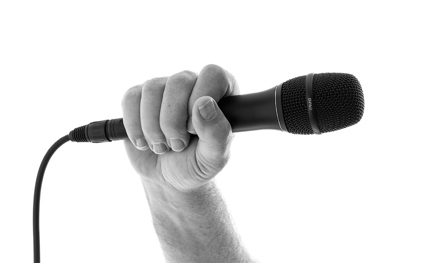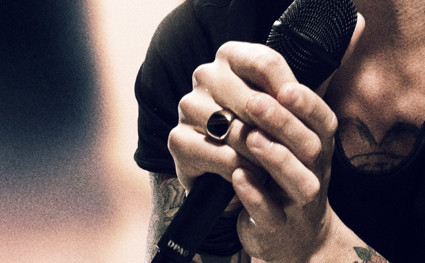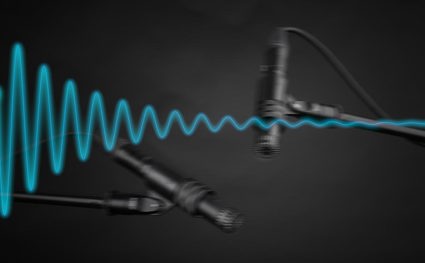How to mic vocals with handheld mics on stage

Guidelines for miking vocals on stage
When choosing a microphone for a vocal performance, audio technicians often tend to select what they have seen on stages for years. The legendary ice cream cone shape, well established by brands such as Shure, is how many believe a vocal microphone should look.
In reality, so many other parameters are more important than shape. Which characteristic should we choose? How should it sound? How should it respond to the details of the voice? Should we select stage monitors or an in-ear system? Should the mic be wired or wireless? There are so many choices to be made.
Why vocal microphones often look like ice cream cones
Handheld vocal microphones have a certain shape for both historical reasons as well as to meet certain audio needs – most importantly a steady handgrip and controlled wind- and pop-suppression. Both of these basic needs require space in and on the unit, so the shape of the microphone is ergonomically designed for the average hand. For the most efficient wind- and pop-suppression, it is best to have as much distance as possible between the internal diaphragm and the mouth, which requires a certain grille size. At the same time, the overall size of the microphone must be bigger than a small diaphragm, condenser, recording microphone and smaller than a large diaphragm cylinder “bird cage” studio microphone. For the performer, it should be large enough to “hide” behind (like having an instrument) but also small enough to provide a view that enables them to move around the stage and for the audience to see them.

Microphone behavior
From a professional singer’s point of view, the sound color and general response of the microphone should be as true as possible to the sound of her tone. The human voice is a pristine instrument that should not be changed by the microphone. Knowledge and experience teach us that this is best achieved with a condenser microphone capsule, which provides faster and more precise dynamics, as well as a more linear response and higher resolution. Though this principle can be applied to stage performances, the challenge here is to avoid noise and interference from other sound sources being picked up by the microphone. It is often impossible to control both the vocal sound and the band sound, not to mention the surroundings. A condenser microphone has another unique characteristic in comparison to the dynamic: A condenser will linearly reproduce the natural level of sound sources at a distance, whereas a dynamic microphone will generally only react to nearby sound sources.
Performer considerations
The psychological aspects of performing, especially live, should not be underestimated under any circumstance. From the talent’s perspective, the vocal microphone is their instrument and, as such, it is a precious and valuable tool – certainly not without emotional importance. Delivering the right perceptual value – how it feels, how much it weighs, what color it is – all of these minute details matter when choosing a vocal microphone. After all, it is important for most artists to find a microphone that is pleasant to use and perform with, as well as one that can help them in their artistic approach. There are many excellent vocal microphones to choose from, so it is often comes down to personal preferences.
Microphone technologies
When discussing vocal microphones for use in live settings, one specification that is most often referenced is the directional quality of the microphone. Since very few users will select omnidirectional handheld microphones for use on stage, sound technicians will need to decide which is the best directional pattern for each project. The main options they can select from are cardioid, supercardioid, and hypercardioid. They can also choose headset microphones, which allow placement close to the mouth and don’t necessarily need a narrower directional pattern. Let's start by defining each directional pattern.
- Cardioid – also known as a first-order cardioid – has approximately 6 dB rejection at ±90°, with its highest rejection at 180° (rear)
- Supercardioid – has higher rejection to the sides, approximately 9 dB, whereas it has a 180° back lobe at most frequencies. This pattern is reminiscent of the figure-eight microphone pattern from which it is derived. Users beware: "Super" is not necessarily better; it simply refers to higher side attenuation. Its highest rejection is at approximately ±125°. In addition, be careful not to confuse the supercardioid with the subcardioid (also known as a wide cardioid), a pattern which is in between a cardioid and an omnidirectional
- Hypercardioid – more similar to the figure-eight pattern as it has higher side rejection, approximately 12 dB, and is more open to the rear, with a rejection of approximately 6 dB.
All directionalities have their pros and cons. Most important for the live engineer to consider when selecting a microphone, is the varying rejection properties of each unit. Understanding these properties and being able to incorporate them is key to getting the best audio from a microphone.
Live engineering
Gain-to-feedback ratio is the most important parameter to consider in live engineering. If the ratio between the levels of the voice were as high as that of all the other sound levels around it, we would have no problem. In reality, the voice is not able to compete with the stage monitors or loud instruments, such as drums and guitars. When creating the perfect level, it is important to remember that a supercardioid microphone is more sensitive to sound from the rear (180°) than the cardioid so this angle should be avoided when using a supercardioid. On the other hand, the supercardioid has higher side rejection.
To make things more difficult, microphones change behavior when used by a singer because the human head acts as an acoustic reflector for some frequencies. The result is a noticeable change of the directional characteristics; typically, the microphone becomes less directional. The most important concern in this situation is not whether to select a cardioid or a supercardioid, but rather the SPL of the outside noise that you are trying to avoid!
This is where the question of using stage monitors or an in-ear system comes into consideration. It is not the scope of this article to discuss this but seen solely from a gain to feedback ratio struggle for the microphone, an in-ear system is preferred.
Proximity effect – how close can you go?
There is always a cause and a consequence. For vocal stage microphones, this is the typical scenario: Isolation from other sound sources is desired so a directional (cardioid, supercardioid or hypercardioid) microphone is selected.
Directional microphones are pressure gradient types using softer diaphragms, which are more pliable and create unwanted sounds that do not derive from the voice, like pop and wind. This is why most stage microphones need some sort of foam windscreen and pop filtering. Users beware: Foam windscreens may change the behavior of the microphone’s high-frequency response and directional characteristics. In many cases, shock absorption is also necessary due to the higher dispersion from the softer diaphragm material.
In these cases, to obtain higher output or to create a more intimate performance, singers often have their lips on the grid of the microphone head. However, putting their mouth too close to the microphone will result in an annoying acoustic distortion and will sound a bit rattled. (Try speaking with a finger right in front of your lips, and you will hear this!) Under these conditions, be sure to pay attention to the microphone’s ability to handle high sound levels. Peak sound pressure levels at above 150 dB are not unusual for singers who have the microphone right in front of their lips. Experienced singers perform with a short distance between their mouth and the microphone, which will influence the bass level of a cardioid (pressure gradient) microphone.

Either way, the fact remains, when dealing with directional microphones, the bass level will be dependent on the distance between the microphone and the singer’s mouth. A good vocal microphone will have its proximity effect tailored to this specific purpose. It will also feature a reasonable distance tolerance for it to work within.
Wired or wireless
The freedom to move around without a cable is tempting but still quite expensive compared to wired versions and not entirely without noise and distortion. Normally, you choose your vocal microphone to either be wired or wireless. One of the DPA vocal microphones – the d:facto™ Vocal Microphone – can be delivered as a cabled unit, but it can also neatly be customized to wireless by simply unscrewing the microphone head and mounting it on a wireless handle. The 2028 Vocal Microphone can be purchased either wired or in one of two different wireless versions.




